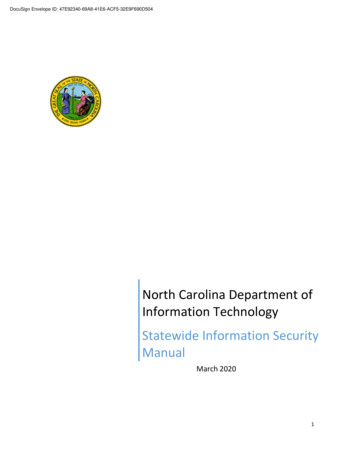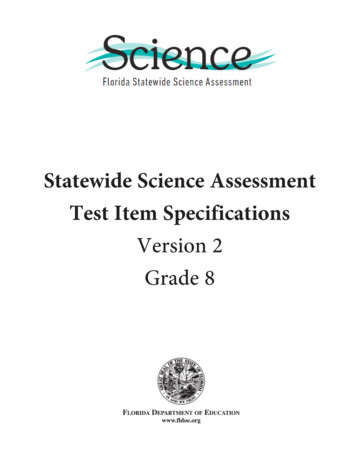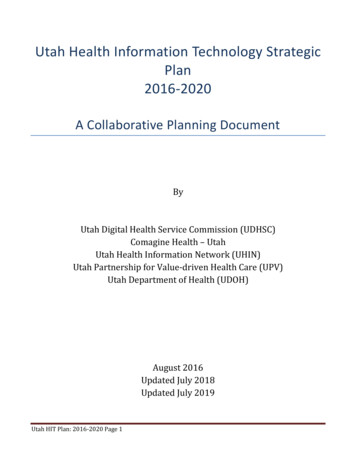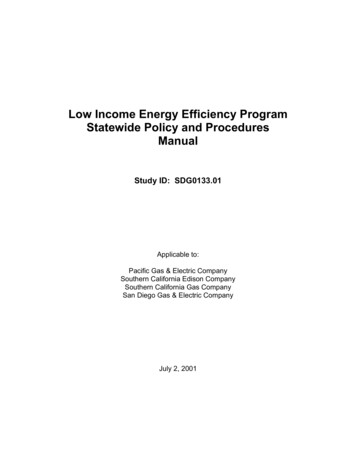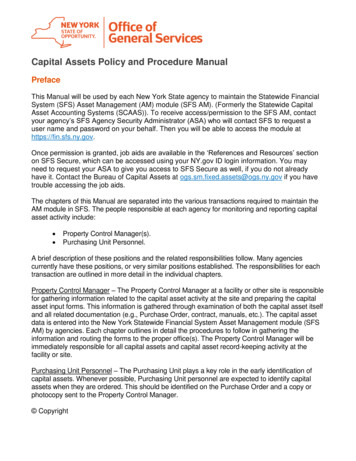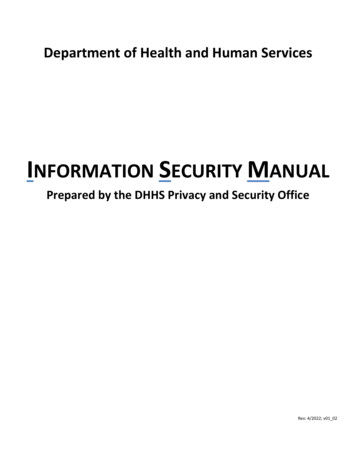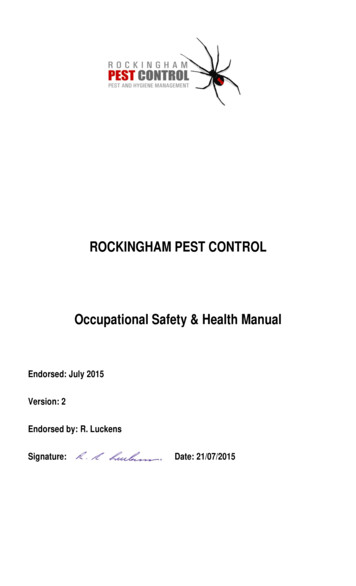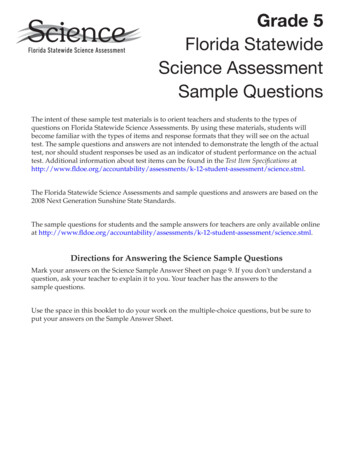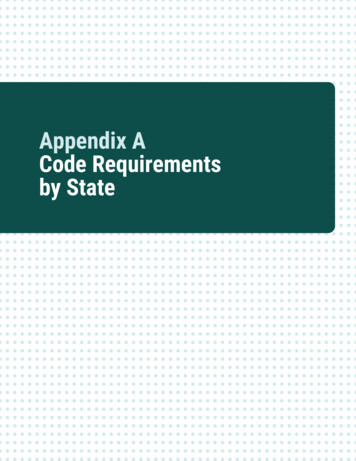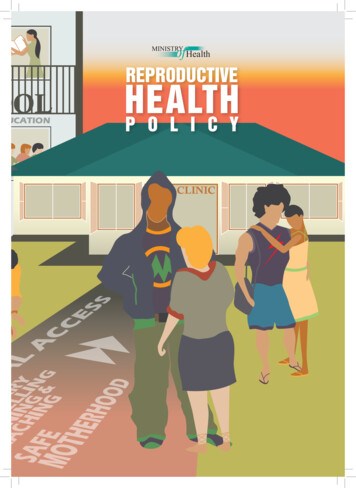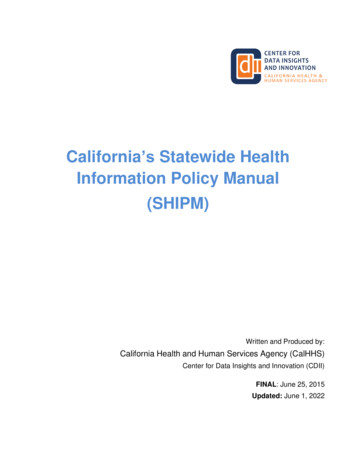
Transcription
California’s Statewide HealthInformation Policy Manual(SHIPM)Written and Produced by:California Health and Human Services Agency (CalHHS)Center for Data Insights and Innovation (CDII)FINAL: June 25, 2015Updated: June 1, 2022
Statewide Health Information Policy ManualDear SHIPM User:Welcome to the revised California Statewide Health Information Policy Manual (SHIPM) usercommunity. SHIPM is updated annually after a thorough analysis of enacted legislation andstate policy.This manual was developed by the former California Health and Human Services Agency’s(CalHHS) Office of Health Information Integrity (CalOHII) which is now the CalHHS Center forData Insights and Innovation (CDII). CDII will continue to maintain the SHIPM on an annualbasis.The SHIPM is an important tool that helps CDII fulfill its statutory responsibility to providestatewide leadership, coordination, direction, and oversight of the Health Insurance Portabilityand Accountability Act (HIPAA) implementation and compliance, including the setting ofstatewide policy.Our goal in providing this manual is to offer state departments a resource that: Facilitates the appropriate sharing of health information rather than using HIPAA as abarrier,Provides departments guidance on how to protect patient privacy while promotingcoordinated care,Promotes uniform interpretation and application of health information laws includingthose relating to security, patients’ rights, and transactions and code sets, andHelps state entities avoid fines and sanctions resulting from unauthorized disclosures ofhealth information.State entities including all state departments, boards, commissions, programs, andother organizational units of the executive branch of state government that are requiredto comply with HIPAA must comply with the California SHIPM policies.For entities not defined by HIPAA as covered entities or business associates, the CaliforniaSHIPM serves as guidance. These entities may find themselves impacted by HIPAA due toreceipt, access, storage, transmission, disclosure, or usage of health information.State entities are also responsible to know and comply with other legal requirements unique toeach state entity and ensure that those provisions are included in the state entity’s ownpolicies and procedures, if not already addressed in the SHIPM.The SHIPM provides direction to help staff working with health information become and remaincompliant with HIPAA, as well as other state and federal privacy laws and standards including,but not limited to, the Confidentiality of Medical Information Act (CMIA), the Information
Statewide Health Information Policy ManualPractices Act (IPA), the Lanterman-Petris-Short Act (LPS), the Lanterman DevelopmentalDisabilities Act, the California Penal Code, the California Health and Safety Code, the PatientsAccess to Health Records Act (PAHRA), the Genetic Information Nondiscrimination Act(GINA), the California State Administrative Manual (CA SAM), and the National Institute ofStandards and Technology (NIST).CDII, with our state department partners, performed legal review of each policy. Preemptionanalysis was built into the development and review of each policy. If departments impacted byHIPAA (and related laws) follow the SHIPM tenets to develop and manage department-specificpolicies and procedures, they will help implement and maintain compliance with HIPAA, andthe other state and federal laws referenced in the policies.CDII may conduct statutorily required compliance reviews based on the policies in this manual.Each department impacted by HIPAA and related laws should ensure its internal policies andprocedures align with the standards and requirements in the SHIPM.Finally, we welcome your feedback on the manual. The SHIPM is intended to be a useful,living document that provides on-going guidance and support to HIPAA-impacted statedepartments. We expect it to be an ongoing, well-used and well-trusted resource. To ensurethe SHIPM’s ongoing effectiveness, please send any recommended changes to CDII forconsideration at CDIIPrivacyOffice@chhs.ca.gov.Sincerely,Elaine Scordakis, MSChief Deputy DirectorCenter for Data Insights & InnovationJohn OhanianDirectorCenter for Data Insights & Innovation
Statewide Health Information Policy ManualTable of ContentsHow to Use this Manual . 6Chapter 1 – Overview . 10Section: 1.1.0 – CDII Authority .111.1.1 – CDII Authority . 11Section: 1.2.0 – State Agency Responsibility .131.2.1 – State Agency Responsibility . 13Chapter 2 – Privacy . 15Section: 2.1.0 – Authorizations .162.1.1 – Authorizations . 16Section: 2.2.0 – Uses and Disclosures .212.2.1 – Decedents . 212.2.2 – Employers . 242.2.3 – Fundraising . 272.2.4 – Health Oversight . 292.2.5 – Judicial and Administrative Proceedings . 332.2.6 – Law Enforcement . 362.2.7 – Marketing . 402.2.8 – Opportunity to Agree or Object. 432.2.9 – Organ Procurement . 472.2.10 – Public Health Activities . 492.2.11 – Required by Law and Required Disclosures . 522.2.12 – Research . 552.2.13 – Specialized Government Functions . 582.2.14 – Treatment, Payment and Health Care Operations (TPO) . 632.2.15 – Underwriting . 662.2.16 – Victims of Abuse, Neglect, or Domestic Violence . 682.2.17 – Health Information Exchange (HIE) . 71SHIPM (rev 6/2022)Page 2
Statewide Health Information Policy Manual2.2.18 – Hybrid Entities (MOVED to 4.6.5). 75Section: 2.3.0 – Specially Protected Information .762.3.1 – Genetic Information . 762.3.2 – HIV/AIDS Information . 782.3.3 – Mental Health Records . 812.3.4 – Substance Use Disorder Treatment . 872.3.5 – Developmental Services Records . 942.3.6 – Psychotherapy Notes . 99Section: 2.4.0 – Breach and Breach Notification .1032.4.1 – Breach and Breach Notification . 103Section: 2.5.0 – De-identification .1102.5.1 – De-identification . 110Section: 2.6.0 – Incidental Disclosures.1142.6.1 – Incidental Disclosures . 114Section: 2.7.0 – Minimum Necessary .1162.7.1 – Minimum Necessary . 116Section: 2.8.0 – Patient’s (Personal) Representative .1182.8.1 – Patient’s (Personal) Representative . 118Section: 2.9.0 – Requirements for Telehealth .1212.9.1 – Requirements for Telehealth . 121Section: 2.10.0 – Multiple Covered Functions .1232.10.1 – Multiple Covered Functions . 123Chapter 3 – Security . 125Section: 3.0 – Cross Reference .126Section: 3.1.0 – Administrative Safeguards.1293.1.1 – Contingency Plans . 1293.1.2 – Incident Procedures . 1323.1.3 – Information Access Management . 1363.1.4 – Security Management Process . 139SHIPM (rev 6/2022)Page 3
Statewide Health Information Policy Manual3.1.5 – Security Awareness and Training. 1453.1.6 – Security Evaluations . 1473.1.7 – Verification of Identity (Person or Entity Authentication) . 1493.1.8 – Workforce Security (RETIRED June 2017) . 152Section: 3.2.0 – Physical Safeguards .1533.2.1 – Access Control (MOVED to 3.3.5) . 1533.2.2 – Device and Media Controls . 1543.2.3 – Facility Access Controls . 1583.2.4 – Workstation Use and Security . 162Section: 3.3.0 – Technical Safeguards .1663.3.1 – Audit Controls. 1663.3.2 – Encryption . 1703.3.3 – Access Administration (RETIRED June 2017) . 1723.3.4 – Integrity . 1733.3.5 – Access Control . 175Section: 3.4.0 – Policy and Procedures.1783.4.1 – Documentation . 178Chapter 4 – Administrative . 183Section: 4.1.0 – Administrative Requirements .1844.1.1 – Policies and Procedures . 1844.1.2 – Privacy Training . 1884.1.3 – Sanctions for Violation . 1904.1.4 – Staffing: Privacy Official, Security Official. 1934.1.5 – Trading Partner Agreements . 1984.1.6 – Waiver of Rights Related to HIPAA Complaints . 200Section: 4.2.0 – Compliance .2014.2.1 – Consequences of Non-Compliance. 201Section: 4.3.0 – Transactions and Code Sets .2054.3.1 – Transactions and Code Sets (TCS) . 205SHIPM (rev 6/2022)Page 4
Statewide Health Information Policy ManualSection: 4.4.0 – Business Associates.2084.4.1 – Business Associate Agreement. 2084.4.2 – Oversight of Business Associates . 213Section: 4.5.0 – Identifiers .2164.5.1 – Provider, Employers Identifiers . 216Section: 4.6.0 – Requirements for Specific Organizations .2184.6.1 – Contractors. 2184.6.2 – Health Care Clearinghouses . 2204.6.3 – Health Information Organizations . 2224.6.4 – Pharmaceutical Companies . 2254.6.5 – Hybrid Entities . 226Chapter 5 – Patient Rights . 229Section: 5.1.0 – Accounting of Disclosures .2305.1.1 – Accounting of Disclosures . 230Section: 5.2.0 – Amendments .2345.2.1 – Patient’s (Individual’s) Right to Amend Medical Records . 234Section: 5.3.0 – Notice of Privacy Practices .2385.3.1 – Notice of Privacy Practices. 238Section: 5.4.0 – Patient Rights - Access .2415.4.1 – Patient’s (Individual’s) Right to Access Health Information . 241Section: 5.5.0 – Restrictions.2495.5.1 – Restriction for Self-Pay . 2495.5.2 – Confidential Communication . 252SHIPM Definitions . 254Summary of Privacy Laws . 278SHIPM (rev 6/2022)Page 5
Statewide Health Information Policy ManualHow to Use this ManualLegal Review:This manual is intended to be a guide for use by those implementing and maintainingdepartment policies relating to health information.Due to their complex nature, the following policies contain language recommending additionalreview and interpretation by each department’s legal department for guidance inimplementation and maintenance of operational policies and procedures: Chapter 2: Privacy – Uses and Disclosures – Employers Chapter 2: Privacy – Uses and Disclosures – Health Oversight Chapter 2: Privacy – Uses and Disclosures – Judicial and Administrative Proceedings Chapter 2: Privacy – Uses and Disclosures – Law Enforcement Chapter 2: Privacy – Uses and Disclosures – Opportunity to Agree or Object Chapter 2: Privacy – Uses and Disclosures – Organ Procurement Chapter 2: Privacy – Uses and Disclosures – Public Health Activities Chapter 2: Privacy – Uses and Disclosures – Required by Law and RequiredDisclosures Chapter 2: Privacy – Uses and Disclosures – Research Chapter 2: Privacy – Uses and Disclosures – Victims of Abuse, Neglect, or DomesticViolence Chapter 2: Privacy – Specially Protected Information – HIV/AIDS Information Chapter 2: Privacy – Specially Protected Information – Mental Health Records Chapter 2: Privacy – Specially Protected Information – Substance Use DisorderTreatment Chapter 2: Privacy – Specially Protected Information – Developmental ServicesRecords Chapter 2: Privacy – Specially Protected Information – Psychotherapy Notes Chapter 2: Privacy – Patient’s (Personal) Representative – Patient’s (Personal)Representative Chapter 3: Security – Administrative Safeguards – Verification of Identity (Person orEntity Authentication)SHIPM (rev 6/2022)Page 6
Statewide Health Information Policy Manual Chapter 4: Administrative – Administrative Requirements – Sanctions for Violation Chapter 4: Administrative – Business Associates – Business Associate Agreement Chapter 5: Patient Rights – Patient Rights – Access - Patient’s (Individual’s) Right toAccess Health Information Chapter 5: Patient Rights – Restrictions - Restriction for Self-Pay Summary of Privacy LawsSHIPM (rev 6/2022)Page 7
Statewide Health Information Policy ManualHow to Navigate this Document: Each policy is linked to the Table of Contents. Using the Control Key and Clicking thepolicy name/table of contents item will navigate directly to the policy from the Table ofContents. Definitions: Definitions associated with the SHIPM policies, are included in the lastsection of this document. The first time the definition is used in a policy, words andphrases that have SHIPM definitions are hyperlinked to the corresponding definition.The definitions include the source, citation, and the majority are based on statute.However, definitions might differ from what is familiar because they may includeelements of HIPAA, state, and other federal law.o All forms of the word are included under one (1) definition (e.g., patient, patients,and patient’s would all be listed under “patient” in the definitions)Attachments: Attachments to policies on the SHIPM webpage are included as separatedocuments. Attachment file names on the SHIPM webpage include the policy numberfor easy reference.How to Interpret Lists of Items (numbered, lettered, or bulleted):In the absence of any language to the contrary, assume that it is a list of “OR” items and thatthe direction applies to each of the items independently.For example, in the following list, the reader must disclose for any of the following reasons.Health information shall be disclosed under the following circumstances:a. By a court pursuant to an order of that courtb. By a board, commission, or administrative agency pursuant to an investigativesubpoenac. By a search warrant lawfully issued to a governmental law enforcement agencyIn this example, the reader must disclose health information if requested by a court order OR asubpoena OR a search warrant.SHIPM (rev 6/2022)Page 8
Statewide Health Information Policy ManualTopic Format:The format of each chapter and section is consistent from topic to topic. The followingsummarizes how each policy topic is organized:I. PurposeThis section briefly states why this policy has been included in the manual and its intendedfunction.II. PolicyThis section contains a clear and explicit general policy statement. Most often, this policylanguage applies equally to all covered entities, inside or outside state service. Anyprovisions specific only to state entities are documented in this section.III. Implementation SpecificsThis section provides more specific details on implementing the policy. Occasionally, stateentities have additional restrictions or responsibilities beyond those of non-state coveredentities due to the Information Practices Act (IPA) or other statutes. These details areidentified in this section.IV. ReferencesThis section lists legal citations upon which this policy is based. This includes not onlyHIPAA, CMIA, California IPA, California Health and Safety Code (CA Health and SafetyCode), California Welfare and Institutions Code (CA Welfare and Institutions Code), butalso the California State Administrative Manual (CA SAM), National Institute of Standardsand Technology (NIST), and other applicable rules.V. Related PoliciesThis section identifies related policies, which may help clarify or amplify the current policy.Referenced policies are presented with the SHIPM chapter number and policy name (forexample SHIPM Chapter 4 – Policies and Procedures).VI. AttachmentsThis section lists any documents related to the policy.SHIPM (rev 6/2022)Page 9
Statewide Health Information Policy ManualChapter 1 – OverviewSHIPM (rev 6/2022)Page 10
Statewide Health Information Policy ManualChapter: 1 – OverviewSection: 1.1.0 – CDII Authority1.1.1 – CDII Authority13BReview Date: 06/01/2022Revision Date: 06/01/2022Attachments: NoI. PurposeTo summarize the authority and responsibilities of the Center for Data Insights andInnovations (CDII) and ensure full and proper implementation and oversight of the federalHealth Insurance Portability and Accountability Act (HIPAA) and related state and federallaws.CDII’s authority is the basis for this Policy Manual.II. PolicyCalifornia law requires CDII to provide statewide leadership, coordination, policyformulation, direction, and oversight for HIPAA compliance. CDII must also exercise fullauthority over state entities to establish policy, provide direction, monitor progress, andreport on compliance efforts. CDII’s mandate to provide uniform implementation of HIPAAincludes the authority to conduct preemption analyses and set policy based on the resultsof the analyses.State entities are responsible for implementing and adopting the policies outlined in theCalifornia Statewide Health Information Policy Manual (SHIPM). State entities mustcooperate with CDII’s compliance efforts, provide documentation or information uponrequest in the format requested, and assist in periodic statewide assessments to determinewhich state entities are impacted by HIPAA. State entities must comply with the decisionsof CDII’s Director regarding implementation and compliance with HIPAA standards.[CA Health and Safety Code §§ 130203(f)(1) – (f)(8)]III. Implementation SpecificsA. CDII Statutory Authority. CDII is required to:1. Specify tools, such as protocols for assessment and reporting.2. Develop uniform policies and provide training on privacy, security, patient rights,transactions and code sets, and other matters related to HIPAA. These policiesmust be adopted and implemented by state entities. The policies are also intendedto provide a clear understanding of law for state entities that have oversight of otherSHIPM (rev 6/2022)1.1.1 – CDII AuthorityPage 11
Statewide Health Information Policy Manualimpacted organizations (such as: state, county, and private sector), soimplementation and enforcement is consistent and accurate.3. Conduct periodic compliance reviews, including Corrective Action Plan monitoringand technical assistance.4. Conduct periodic HIPAA entity assessment surveys to determine which stateentities are subject to HIPAA.5. Develop standards for state and federal health information law compliance reviewsof state departments.6. Represent the State of California in HIPAA discussions with the U. S. Department ofHealth and Human Services (HHS) and national and regional groups developingstandards.7. Provide state entities with technical assistance.8. Establish and maintain a public website to provide information in a clear, consistentformat concerning state HIPAA implementation activities.9. Review and approve all legislation that is related to administrative aspects ofHIPAA, proposed by state entities and review all analyses and positions on HIPAArelated legislation being considered by either the Congress or the Legislature.[CA Health and Safety Code §§ 130200 – 130203(f)(8)]B. Preemption. CDII is responsible for leadership, coordination, direction, and oversightregarding HIPAA preemption analyses including determining which statutoryrequirements apply and setting policy based upon this determination. State entitiesimpacted by HIPAA, at the direction of CDII, must assist in completing HIPAApreemption analyses.[CA Health and Safety Code § 130203(f)(1)(ii)]IV. ReferencesCA Health and Safety Code §§ 130200 – 130211V. Related PoliciesSHIPM Chapter 2 – PrivacySHIPM Chapter 3 – SecuritySHIPM Chapter 4 – AdministrativeSHIPM Chapter 5 – Patient RightsVI. AttachmentsNoneSHIPM (rev 6/2022)1.1.1 – CDII AuthorityPage 12
Statewide Health Information Policy ManualChapter: 1 – OverviewSection: 1.2.0 – State Agency Responsibility1.2.1 – State Agency Responsibility14BReview Date: 06/01/2022Revision Date: 06/01/2022Attachments: NoI. PurposeTo provide guidance regarding state entity responsibilities, relating to the policies in theState Health Information Policy Manual (SHIPM).II. PolicyState entities are required to comply with all SHIPM policies and to incorporate theprovisions into their own policies and procedures.III. Implementation SpecificsState entities are responsible to:A. Know legal requirements unique to each state entity and ensure that those provisionsare included in the state entity’s own policies and procedures, if not already addressedin the SHIPM.B. Incorporate the protections, provisions, and requirements of the SHIPM into the stateentity’s own policies and procedures.[CA Health and Safety Code §§130200 – 130203(f)(8)]C. Establish procedures describing when to engage legal staff on activities related tospecific SHIPM policies, particularly those policies that advise consulting legal counsel.D. Provide workforce training on SHIPM policies as incorporated into individual state entitypolicies and procedures as appropriate based on the workforce member’s role andresponsibilities.[45 C.F.R. § 164.308, and § 164.530]E. Provide feedback and comments to Center for Data Insights and Innovation (CDII)regarding SHIPM policies, notices of proposed rule-making, other documents oractivities related to Health Insurance Portability and Accountability Act (HIPAA)implementation, compliance, and other state and federal health information privacy andsecurity laws.[CA Health and Safety Code §130203(d)]SHIPM (rev 6/2022)1.2.1 – State Agency ResponsibilityPage 13
Statewide Health Information Policy ManualF. Respond in a timely and complete manner to all activities undertaken to assess andensure implementation and compliance with SHIPM policies. Responses shall include,but are not limited to:1. Assisting in periodic statewide assessments2. Assisting in and partnering with periodic compliance reviews3. Providing documentation or information upon request in the format requested[CA Health and Safety Code §§ 130203 – 130203(f)(8)]G. Comply with the decisions of the CDII director in achieving compliance with state andfederal health information privacy and security laws.[CA Health and Safety Code § 130203(e)]H. In addition to policies and authorities outlined in SHIPM, state entities must also compl
policies and procedures, they will help implement and maintain compliance with HIPAA, and the other state and federal laws referenced in the policies. CDII may conduct statutorily required compliance reviews based on the policies in this manual. Each department impacted by HIPAA and related laws should ensure its internal policies and
